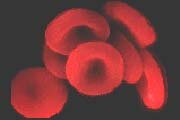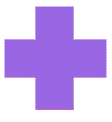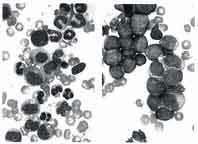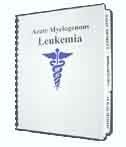|
Leukemia Symptoms and Diagnosis
Leukemia Symptoms
Acute myelogenous leukemia (AML) symptoms result from the body not producing enough healthy blood cells. Healthy bone marrow makes stem cells that grow into the three types of blood cells: red blood cells, white blood cells, and platelets. An AML patient's bone marrow makes too many blast cells (immature white blood cells). Normal blast cells turn into a type of white blood cell called granulocytes, but the leukemia blast cells do not. At the same time, the marrow cannot grow enough normal red blood cells, white blood cells, and platelets.
Someone with too few red blood cells (anemia) may:
· Feel tired
· Be short of breath
· Look pale
Someone with too few normal white blood cells and too many leukemia blast cells may:
· Develop a lot of infections, for example, a sore throat
· Experience pain in the bones or joints
· Have a mild fever
Someone with too few platelets may:
· Bleed easily, such as swollen and bleeding gums, frequent nose bleeds or cuts that bleed for a long time
· Bruise more easily than usual
· Develop pin-head sized spots under the skin
· Develop cuts that heal slowly or do not heal
Some people with AML, however, do not notice any symptoms. Their AML may be discovered only during a blood test.
Leukemia Diagnosis
AML is diagnosed by examining bone marrow and blood samples under a microscope. By examining the appearance of the leukemia cells, the sub-type of AML can also be diagnosed. AML has seven sub-types, which are based on the type of blood cells affected. The sub-type of AML is an important factor in choosing the best cancer treatment for a patient.
AML looks like this under a microscope:
|
Normal Cell
|
Acute Myelogenous
Blast Cell |
|
|
On the left side shows normal bone marrow cells. On the right side, the slide shows an acute myelogenous leukemia photograph taken through a microscope of a blast cells. The cells have what is described as a "frozen" appearance.
An additional acute myelogenous leukemia picture is below:

Find out more about&
Cancer Treatment Options
|
























